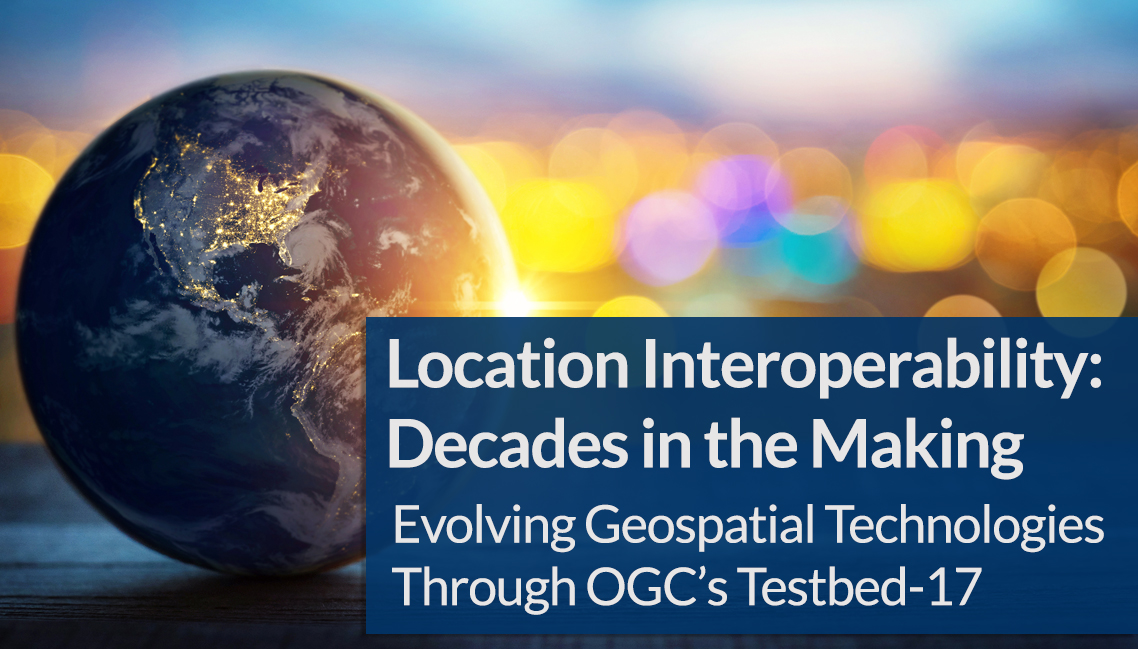Decades in the Making: The Challenges of Evolving Technologies and Standards
When it comes to evolving a technology or standard over multiple decades, the struggle is real. As time changes, so do requirements, use cases, and the need for scalability. What was once a centerpiece to a core infrastructure or service can become dated months after the solution’s release. This problem affects all domains and industries, especially when it comes to geospatial, or location information. It often feels like there is no one group of organizations looking at the big picture.
Enter the OGC Innovation Program, a collaborative effort between organizations from across the globe dedicated to making information more easily accessible and applicable for the location community. To help spur on this consistent year-over-year innovation and open standards creation, OGC Testbeds were born. OGC Testbeds are part of an OGC’s Innovation Program, a collaborative, agile, and hands-on prototyping and engineering environment where sponsors and OGC members come together to address location interoperability challenges while validating international open standards.
Decades in the making, OGC’s Testbed-17 is underway, and is as ambitious of an undertaking as ever. Sponsors such as Defence Science and Technology Laboratory (Dstl), European Space Agency (ESA), Natural Resources Canada (NRCan), US Federal Aviation Administration (FAA) System Wide Information Management (SWIM) Program, US National Aeronautics Space Administration (NASA), and other US government sponsors have gathered with dozens of participants being funded to help solve some of the biggest challenges in location.
Creating Real Impacts: Challenges Addressed by Testbed-17
Over previous Testbed iterations, the OGC Innovation Program has worked to create harmony in all things location. Some examples include connecting data and processes, evolving Earth Observation solutions, analysis-ready data, and more. Each year a technology, process, or standard is introduced, and oftentimes it is grown upon in subsequent years. OGC APIs are an excellent example of this.
With OGC’s long history of evolving technologies, evolving standards have been a crucial part of the process. Beginning with Web Mapping Services (WMS), a set of standards used by organizations across the globe, and rigorously tested and validated through OGC Testbeds, things have continued to evolve. As time moved on, so did the methods for sending vast amounts of data efficiently across the globe. OGC APIs were developed as the building blocks for location to meet this growing demand.
For Testbed-17, OGC APIs are taking center stage through a number of real-world environments, also called threads, to help solve a consistent issue across all technologies and services: interoperability.
The OGC Testbed-17 APIs thread is broken into five categories:
- Attracting Developers: Lowering the entry hurdle for OGC Web API experiments. An examination of current API documentation and standards that aims to create a more modern, approachable, and user friendly entry point for the OGC APIs.
- Geo Data Cubes: Development of a standardized specification for a minimum viable geo data cube and an evaluation of capabilities and method for expanding beyond that minimum viable geo data cube.
- OGC Features and Geometries JSON: Expanding GeoJSON to include a multitude of coordinate reference systems and aviation related challenges
- Web API for Aviation: OGC Web API to elevate the existing SWIM service-based architecture to Web API level
- Compliance Interoperability and Testing Evaluation (CITE): Exploring and defining what an adequate test environment will be for OGC API-Processes.
Developing solutions today to scale tomorrow and beyond
As Testbed-17 continues on, a number of core technologies will remain in the spotlight, all with one core theme: making location information Findable, Accessible, Interoperable, and Reusable. This is achieved both through consortium leadership, and the many participants and sponsors involved.
“The Testbeds provide an unique opportunity to explore technologies that appear disconnected at first glance. Combining these technologies in a single initiative and bringing several sponsors together allows us to create an interoperability environment that comes much closer to real world situations. In consequence, Testbeds allow leveraging an outstanding quality of synergetic effects and to address challenges that require collaboration among several sponsors and experts from member organizations”, says OGC’s CTIO Dr. Ingo Simonis.
Testbed-17 will continue to deliver critical updates on the state of the initiative, and present their findings and successes at the OGC Member Meeting in December this year, a global gathering of leading experts in location that discuss solving problems across the Geospatial domain, and beyond. Their new geospatial problems and solutions will bubble up and evolve into what will become Testbed-18, the next iteration of these core technologies, standards, and more.
